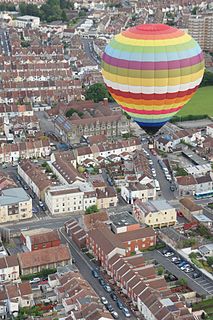Balloon Experiments with Amateur Radio (BEAR) is a series of Canadian-based amateur radio high-altitude balloon experiments by a group of amateur radio operators and experimenters from Sherwood Park and Edmonton, Alberta. The experiments started in the year 2000 and continued with BEAR-9 in 2012 reaching 36,010 metres (118,140 ft). [1] [2]
The balloons are made of latex filled with either helium or hydrogen. All of the BEAR payloads carry a tracking system comprising a GPS receiver, an APRS encoder, and a radio transmitter module. Other experimental payload modules include an Amateur Radio crossband repeater, and a digital camera all of which is contained within an insulated foam box suspended below the balloon. A parachute recovery system is automatically deployed when the balloon bursts at altitude. [3]
On May 27, 2000, this helium-filled balloon with a payload of 0.977 kg, was launched from the Bremner airport, and reached an altitude of 31,762 meters (104,206 feet). [4] This first flight was a test of the GPS receiver used, to ensure that the unit successfully reported location information above the 60,000-foot limit imposed upon manufacturers, as well as the payload enclosure and antenna system to be used for future flights. A Pooh Bear mascot was also included in the payload for luck. [3]
This balloon was launched from an outdoor skating rink at Sherwood Park, Alberta, Canada, on August 5, 2000. It reached 30,322 meters (99,481 feet) before the balloon burst. It landed in the Battle River south of New Norway, but was successfully recovered. [5] [6] This payload contained the same tracking system as proven on BEAR-1, as well as a highly modified Icom IC-24AT handheld configured for crossband repeating. [3] The radio was configured to receive on 446.100 MHz in the UHF band, and repeat the audio automatically on 146.520 MHz in the VHF band. Contacts were made with stations from Cold Lake, AB to Swift Current, SK as well as numerous contacts in the Edmonton, Red Deer, Calgary corridor in Alberta. A last-minute addition to the payload was an inexpensive digital camera. This camera was found to cause interference with the crossband radio on board, and was therefore turned off for the flight. The hole in the payload container for the camera ended up becoming an entry point for water from the river, causing major damage to the onboard electronics. This flight was originally scheduled to fly on July 15, 2000, but was scrubbed early in the evening of July 14 due to a tornado touching down at Pine Lake. Frequency and personnel resources were needed for disaster recovery efforts over the next few days dealing with the aftermath of the event, which left 12 dead.
Reaching 35,475 meters (116,387 feet) on August 22, 2009, BEAR-3 achieved the highest altitude so far for the BEAR series of launches. This balloon was the first in the series to be filled with hydrogen instead of helium. [3] The payload contained a Trimble Lassen iQ GPS, a Byonics Micro-Trak 300 and four AAA lithium L92 batteries. [7] A custom payload enclosure was designed in an effort to attempt to produce an ultra-lightweight payload. A payload mass of 95.8 grams was achieved, which puts it tied with the lightest payload in the Amateur Radio High Altitude Ballooning Records.[ failed verification (See discussion.)] This payload was recovered near Mundare, Alberta.
The balloon was released on August 23, 2009. The flight duration was 3 hours 56 minutes and reached an altitude of 32,658 meters (107,145 feet). [8] [9] [10] This flight was designed to lift a high-definition video camera to altitude, recording video from the entire flight for Tomoya Kamiko from Japan. Tomoya provided the camera, while the BEAR team provided the payload container, tracking hardware, parachute and balloon. This payload was recovered near Mannville, Alberta.
BEAR-5 was launched on April 24, 2010. [11] The APRS payload tracker IDs were VE6ATV-11 for the horizontal antenna and VE6ATV-12 for the vertical antenna. [12] at the standard North American APRS frequency of 144.390 MHz.

An aerobot is an aerial robot, usually used in the context of an unmanned space probe or unmanned aerial vehicle.

Very high frequency (VHF) is the ITU designation for the range of radio frequency electromagnetic waves from 30 to 300 megahertz (MHz), with corresponding wavelengths of ten meters to one meter. Frequencies immediately below VHF are denoted high frequency (HF), and the next higher frequencies are known as ultra high frequency (UHF).

In radio communication, skywave or skip refers to the propagation of radio waves reflected or refracted back toward Earth from the ionosphere, an electrically charged layer of the upper atmosphere. Since it is not limited by the curvature of the Earth, skywave propagation can be used to communicate beyond the horizon, at intercontinental distances. It is mostly used in the shortwave frequency bands.

Automatic Packet Reporting System (APRS) is an amateur radio-based system for real time digital communications of information of immediate value in the local area. Data can include object Global Positioning System (GPS) coordinates, weather station telemetry, text messages, announcements, queries, and other telemetry. APRS data can be displayed on a map, which can show stations, objects, tracks of moving objects, weather stations, search and rescue data, and direction finding data.

In aeronautics, a balloon is an unpowered aerostat, which remains aloft or floats due to its buoyancy. A balloon may be free, moving with the wind, or tethered to a fixed point. It is distinct from an airship, which is a powered aerostat that can propel itself through the air in a controlled manner.

High-altitude balloons are manned or unmanned balloons, usually filled with helium or hydrogen, or in some cases methane, that are released into the stratosphere, generally attaining between 18 and 37 km above sea level. In 2002, a balloon named BU60-1 reached a record altitude of 53.0 km.

The Columbia Scientific Balloon Facility (CSBF) is a NASA facility responsible for providing launch, tracking and control, airspace coordination, telemetry and command systems, and recovery services for unmanned high-altitude balloons. Customers of the CSBF include NASA centers, universities, and scientific groups from all over the world.
JP Aerospace is an American company that aims to achieve affordable access to space. Their main activities include high-atmospheric lighter-than-air flights carrying cameras or miniature experiments called pongsats and minicubes. They are also engaged in an Airship to Orbit project.

Cluster ballooning is a form of ballooning where a harness attaches a balloonist to a cluster of helium-inflated rubber balloons.

The Allsopp Helikite is a type of kite-balloon or kytoon designed by Sandy Allsopp in the UK in 1993. The Helikite comprises a combination of a helium balloon and a kite to form a single, aerodynamically sound tethered aircraft, that exploits both wind and helium for its lift.
The United States Naval Academy (USNA) Small Satellite Program (SSP) was founded in 1999 to actively pursue flight opportunities for miniature satellites designed, constructed, tested, and commanded or controlled by Midshipmen. The Naval Academy's aerospace laboratory facilities are some of the most advanced and extensive in the country. These facilities include structures labs, propulsion and rotor labs, simulation labs, wind tunnels with flow velocities ranging from subsonic to supersonic, computer labs, and the Satellite Ground Station. The SSP provides funds for component purchase and construction, travel in support of testing and integration, coordination with The US Department of Defense or National Aeronautics and Space Administration (NASA) laboratories or with universities for collaborative projects, and guides Midshipmen through the Department of Defense (DoD) Space Experiments Review Board (SERB) flight selection process.
First-person view (FPV), also known as remote-person view (RPV), or simply video piloting, is a method used to control a radio-controlled vehicle from the driver or pilot's view point. Most commonly it is used to pilot a radio-controlled aircraft or other type of unmanned aerial vehicle (UAV). The vehicle is either driven or piloted remotely from a first-person perspective via an onboard camera, fed wirelessly to video FPV goggles or a video monitor. More sophisticated setups include a pan-and-tilt gimbaled camera controlled by a gyroscope sensor in the pilot's goggles and with dual onboard cameras, enabling a true stereoscopic view.

Radio is the technology of signaling and communicating using radio waves. Radio waves are electromagnetic waves of frequency between 30 hertz (Hz) and 300 gigahertz (GHz). They are generated by an electronic device called a transmitter connected to an antenna which radiates the waves, and received by a radio receiver connected to another antenna. Radio is very widely used in modern technology, in radio communication, radar, radio navigation, remote control, remote sensing and other applications.
The Space Systems and Controls Lab is a lab in the Aerospace Engineering Department at Iowa State University located in Ames, Iowa. It is an open and interdisciplanery lab that has research areas in space systems, near space systems, control systems, embedded systems and robotics.
The Spirit of Knoxville is a high-altitude balloon project run by amateur scientists and University of Tennessee students, with the ultimate goal of successfully sending an unmanned balloon across the Atlantic Ocean. The project is named for Charles Lindbergh's record-breaking Spirit of St. Louis aircraft. As of November 2008, five flights have been made, of which three were intended to cross the Atlantic, a goal which has yet to be achieved.
Project Icarus was a project at the Massachusetts Institute of Technology (MIT) in 2009.
SSETI Express was the first spacecraft to be designed and built by European students and was launched by the European Space Agency. SSETI Express is a small spacecraft, similar in size and shape to a washing machine. On board the student-built spacecraft were three CubeSat pico-satellites, extremely small satellites weighing around one kg each. These were deployed one hour and forty minutes after launch. 23 university groups, working from locations spread across Europe and with very different cultural backgrounds, worked together via the internet to jointly create the satellite. The expected lifetime of the mission was planned to be 2 months. Express is the fastest developed micro-satellite in history.
The Yaesu VX series is a line of two sequences of compact amateur radio handheld transceivers produced by Yaesu. There is a line of ultra-compact lower-power dual-band transceivers that started with the VX-1R and was later updated with the VX-2R and VX-3R. There is also a line of 5W tri-band transceivers that started with the VX-5R and was later updated with the VX-6R, VX-7R and VX-8R.

ESTCube-1 is the first Estonian satellite and first satellite in the world to attempt to use an electric solar wind sail (E-sail). It was launched on 7 May 2013 aboard Vega VV02 carrier rocket and successfully deployed into orbit. The CubeSat standard for nanosatellites was followed during the engineering of ESTCube-1, resulting in a 10×10×11.35 cm cube, with a volume of 1 liter and a mass of 1.048 kg.

Zero 2 Infinity is a private Spanish company developing high-altitude balloons to provide access to near space and low Earth orbit using a balloon-borne pod and a balloon-borne launcher.